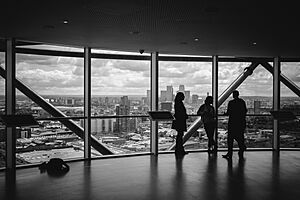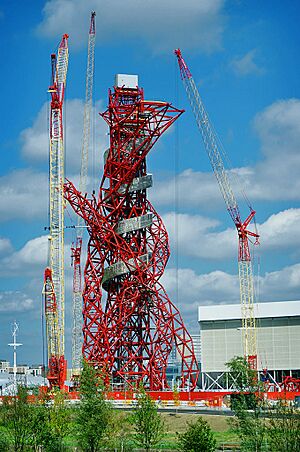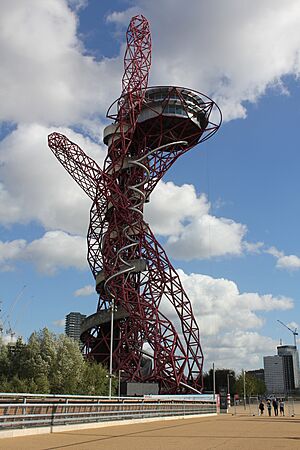ArcelorMittal Orbit facts for kids
Quick facts for kids ArcelorMittal Orbit |
|
|---|---|
 |
|
| General information | |
| Type | Observation tower |
| Location | Queen Elizabeth Olympic Park London, E20 United Kingdom |
| Coordinates | 51°32′18″N 0°0′48″W / 51.53833°N 0.01333°W |
| Estimated completion | May 2012 |
| Opened | April 2014 |
| Cost | £22.7 million |
| Owner | Olympic Park Legacy Company (on completion), ownership transferred to London Legacy Development Corporation |
| Management | ENGIE Services Limited on behalf of London Legacy Development Corporation |
| Height | 114.5 m (376 ft) |
| Technical details | |
| Floor area | 300 m2 (3,229 sq ft) |
| Design and construction | |
| Architect | Designed by Anish Kapoor with Sir Cecil Balmond of Arup Group, architect Ushida Findlay Architects |
| Developer | Arcelor Mittal and London Development Agency |
| Structural engineer | Arup |

The ArcelorMittal Orbit is a super tall and twisty sculpture that's also an observation tower. It stands 114.5 meters (about 376 feet) high in the Queen Elizabeth Olympic Park in Stratford, London. It's the biggest piece of public art in Britain!
This amazing structure was built to be a lasting reminder of the 2012 Olympic and Paralympic Games held in London. It also helps to bring new life to the Stratford area after the Games. You can find it between the London Stadium and the London Aquatics Centre. Visitors can go up to two viewing platforms to see the whole Olympic Park and the London skyline.
The Orbit was designed by famous artist Sir Anish Kapoor and engineer Cecil Balmond from Arup Group. It was announced in 2010 and opened to the public in April 2014. The idea came about because London's mayor, Boris Johnson, wanted "something extra" for the Olympic Park.
The project cost £22.7 million. Most of the money, £16 million, came from Lakshmi Mittal, who owned the ArcelorMittal steel company. That's why it's called the "ArcelorMittal Orbit"! The rest of the money came from the London Development Agency.
After the 2012 Games, the Orbit closed for a while as the area around it was rebuilt. It re-opened in 2014. In 2016, something super cool was added: the world's tallest and longest tunnel slide! It's 178 meters (about 584 feet) long and even has clear sections so you can see out as you zoom down.
Contents
History of the Orbit
Why Was the Orbit Built?
Around 2008, London's mayor, Boris Johnson, and the Olympics Minister, Tessa Jowell, thought the Olympic Park needed something special. They wanted a landmark that would make the East London skyline stand out and make people curious.
They held a design competition in 2009, asking for ideas for an "Olympic tower" that was at least 100 meters (328 feet) tall. About 50 different designs were sent in. Johnson had first imagined something simpler, like a tall column, but then more exciting ideas came along.
How Lakshmi Mittal Got Involved
The steel boss, Lakshmi Mittal, became interested in funding the project. He met Boris Johnson by chance in 2009 and Johnson quickly told him about the idea. Mittal agreed to provide the steel. He later said he didn't realize how big the project would become, thinking it was just about supplying some steel. But he ended up helping with the whole project.
Choosing the Design
On March 31, 2010, Kapoor and Balmond's Orbit design was chosen as the winner. It was picked by a group of nine experts. They decided that the Orbit best represented the Olympic Games and could be built in time. Kapoor called it the "commission of a lifetime."
When the project was launched, Boris Johnson knew some people might think it was crazy to build such a big piece of art during a tough economic time. But he and Tessa Jowell were sure it was the right thing for the Olympic site, both during and after the Games. The finished structure was officially shown to the public on May 11, 2012.
Designing the Orbit
Who Designed It?
The Orbit was designed by Turner Prize-winning artist Anish Kapoor and Cecil Balmond, a leading engineer. Both men are interested in how art and engineering can come together. They had worked together before on other art projects.
The engineering company Arup helped bring the design to life. They figured out the shape, how it would stand up, and even the lighting. An architect named Kathryn Findlay also helped make it a usable building, for example, by designing the staircase.
How is it Built?
The Orbit has two main parts:
- The trunk: This is the more-or-less straight tower in the middle. It holds the elevators and stairs and supports the viewing platforms.
- The red tube: This is a twisting, open frame of red steel that wraps around the trunk.
The trunk is wider at the bottom, gets narrower in the middle, and then widens again near the top. The red tube helps support and stabilize the whole structure, making it very strong. There are also steel rings and diagonal connectors that add to its strength.
A special part is the canopy, which is a cone shape hanging from the bottom of the trunk. It's made of 117 specially shaped steel panels and weighs 84 tonnes!
How Tall is the Orbit?
The Orbit is 114.5 meters (376 feet) tall. This makes it the tallest sculpture in the UK!
To give you an idea of its height:
- It's about 22 meters (72 feet) taller than the Statue of Liberty (without its pedestal).
- It's much shorter than the Eiffel Tower, which is 324 meters (1,063 feet) tall.
- It's a bit taller than the Big Ben clock tower (96.3 meters or 316 feet).
- It's more than double the height of Nelson's Column (51.5 meters or 169 feet).
- It's almost as tall as the Great Pyramid of Giza in Egypt, which was originally about 146 meters (480 feet) tall.
Building the Tower
The Orbit is located in the southern part of the Olympic Park. Construction started in November 2010 and it reached its full height in November 2011.
Steel was the main material used because it's super strong and can be shaped into the twisting design. About 2,000 tonnes of steel were used, much of it from ArcelorMittal plants. A lot of this steel, 60%, was recycled!
Building such a unique structure needed a lot of careful planning and work from engineers.
What You Can Do at the Orbit
Visiting the Observation Tower
As an observation tower, the Orbit has two indoor viewing platforms. Each platform can hold 150 people. From the top, you get amazing views of the 250-acre Olympic Park and the London skyline.
Visitors usually take an elevator to the top and then walk down the 455-step staircase. This lets you enjoy the views and the sculpture's design as you go down. The tower can handle about 700 visitors every hour. During the Olympic Games, it cost £15 for adults and £7 for children to enter. There isn't a restaurant inside, but there's a cafe and shop nearby.
The World's Longest Tunnel Slide
In 2016, a permanent slide designed by German artist Carsten Höller was added to the sculpture. This slide is the world's tallest and longest tunnel slide, measuring 178 meters (584 feet)! It twists and turns around the tower, with some clear sections so you can see outside. Riding the slide costs extra, but it's a thrilling way to experience the Orbit.
A Lasting Legacy
The goal for the Orbit was to be a main attraction during the Olympic Games and then become a permanent tourist spot. It's meant to help the Stratford area continue to grow and attract visitors for many years to come.
During the opening ceremony of the 2012 Summer Paralympics, a Royal Marine named Joe Townsend even delivered the Paralympic flame into the Olympic Stadium by zipline from the top of the Orbit!
Funding the Orbit
The total cost of the Orbit was £22.7 million. ArcelorMittal provided £16 million, and the London Development Agency gave £3.1 million. Lakshmi Mittal said he wanted to help because he lives in London and saw it as a chance to build something spectacular for the city and the Olympic Games. He also wanted to show off the amazing qualities of steel.
An expert on the advisory panel, Nicholas Serota, who directs the Tate gallery, praised Mittal for supporting such a "great commission."
See also
 In Spanish: ArcelorMittal Orbit para niños
In Spanish: ArcelorMittal Orbit para niños




